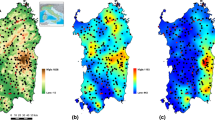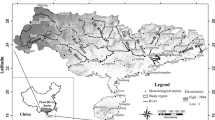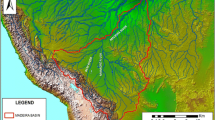Abstract
Extreme high precipitation amounts are among environmental events with the most disastrous consequences for human society. This paper deals with the identification of ‘homogeneous regions’ according to statistical characteristics of precipitation extremes in the Czech Republic, i.e. the basic and most important step toward the regional frequency analysis. Precipitation totals measured at 78 stations over 1961–2000 are used as an input dataset. Preliminary candidate regions are formed by the cluster analysis of site characteristics, using the average-linkage clustering and Ward’s method. Several statistical tests for regional homogeneity are utilized, based on the 10-yr event and the variation of L-moment statistics. In compliance with results of the tests, the area of the Czech Republic has been divided into four homogeneous regions. The findings are supported by simulation experiments proposed to evaluate stability of the test results. Since the regions formed reflect also climatological differences in precipitation regimes and synoptic patterns causing high precipitation amounts, their future application may not be limited to the frequency analysis of extremes.
Similar content being viewed by others
References
Adamowski K., 2000. Regional analysis of annual maximum and partial duration flood data by nonparametric and L-moment methods. J. Hydrol., 229, 219–231.
Alila Y., 1999. A hierarchical approach for the regionalization of precipitation annual maxima in Canada. J. Geophys. Res., 104, 31645–31655.
Alila Y., 2000. Regional rainfall depth-duration-frequency equations for Canada. Water Resour. Res., 36, 1767–1778.
Chowdhury J.U., Stedinger J.R. and Lu L.-H., 1991. Goodness-of-fit tests for regional generalized extreme value distributions. Water Resour. Res., 27, 1765–1776.
Christensen J.H. and Christensen O.B., 2003. Severe summertime flooding in Europe. Nature, 421, 805–806.
Coufal L., Langová P. and Míková T., 1992. Meteorological data in the Czech Republic in the period 1961–1990. National Climatic Programme, Czech Hydrometeorological Institute, Prague, 160 pp. (in Czech, with English summary).
Ekström M., Fowler H.J., Kilsby C.G. and Jones P.D., 2005. New estimates of future changes in extreme rainfall across the UK using regional climate model integrations. 2. Future estimates and use in impact studies. J. Hydrol., 300, 234–251.
Fowler H.J. and Kilsby C.G., 2003a. A regional frequency analysis of United Kingdom extreme rainfall from 1961 to 2000. Int. J. Climatol., 23, 1313–1334.
Fowler H.J. and Kilsby C.G., 2003b. Implications of changes in seasonal and annual extreme rainfall. Geophys. Res. Lett., 30, 1720, doi:10.1029/2003GL01.
Fowler H.J., Ekström M., Kilsby C.G. and Jones P.D., 2005. New estimates of future changes in extreme rainfall across the UK using regional climate model integrations. 1: Assessment of control climate. J. Hydrol., 300, 212–233.
Frich P., Alexander L.V., Della-Marta P., Gleason B., Haylock M., Klein Tank A.M.G. and Peterson T., 2002. Observed coherent changes in climatic extremes during the second half of the 20th century. Clim. Res., 19, 193–212.
Gaál L., 2005. Introduction of Lapin’s indices into the cluster analysis of maximum k-day precipitation totals in Slovakia. Meteorologický časopis, 8, 83–92.
Gellens D., 2002. Combining regional approach and data extension procedure for assessing GEV distribution of extreme precipitation in Belgium. J. Hydrol., 268, 113–126.
Greenwood J.A., Landwehr J.M., Matalas N.C. and Wallis J.R., 1979. Probability weighted moments: Definition and relation to parameters of several distributions expressable in inverse form. Water Resour. Res., 15, 1049–1054.
Guttman N.B., 1993. The use of L-moments in the determination of regional precipitation climates. J. Climate, 6, 2309–2325.
Guttman N.B., Hosking J.R.M. and Wallis J.R., 1993. Regional precipitation quantile values for the continental United States computed from L-moments. J. Climate, 6, 2326–2340.
Hanslian D., Brázdil R., Štekl J. and Kakos V., 2000. The influence of Mediterranean cyclones on high precipitation at Milešovka and Lysá hora in the period 1961–1995. Meteorologické zprávy, 53, 33–41 (in Czech, with English summary).
Hosking J.R.M., 1990. L-moments: Analysis and estimation of distributions using linear combinations of order statistics. J. Roy. Stat. Soc., 52B, 105–124.
Hosking J.R.M., 1994. The four-parameter kappa distribution. IBM J. Res. Develop., 38, 251–258.
Hosking J.R.M. and Wallis J.R., 1993. Some statistics useful in regional frequency analysis. Water Resour. Res., 29, 271–281.
Hosking J.R.M. and Wallis J.R., 1997. Regional Frequency Analysis. An Approach Based on L-moments. Cambridge University Press, Cambridge, New York, Melbourne, 224 pp.
Huth R., Nemešová I. and Klimperová N., 1993. Weather categorization based on the average linkage clustering technique: An application to European mid-latitudes. Int. J. Climatol., 13, 817–835.
IPCC 2001. Climate Change 2001. The Scientific Basis. Cambridge University Press, Cambridge, 881 pp.
Kalkstein L.S., Tan G. and Skindlov J.A., 1987. An evaluation of three clustering procedures for use in synoptic climatological classifications. J. Clim. Appl. Meteorol., 26, 717–730.
Kjeldsen T.R., Smithers J.C. and Schulze R.E., 2001. Flood frequency analysis at ungauged sites in the KwaZulu-Natal Province, South Africa. Water SA, 27, 315–324.
Klein Tank A.M.G. and Koennen G.P., 2003. Trends in indices of daily temperature and precipitation extremes in Europe, 1946–99. J. Climate, 16, 3665–3680.
Lu L.-H. and Stedinger J.R., 1992. Sampling variance of normalized GEV/PWM quantile estimators and a regional homogeneity test. J. Hydrol., 138, 223–245.
Naghavi B. and Yu F.X., 1995. Regional frequency analysis of extreme precipitation in Louisiana. J. Hydraul. Eng.-ASCE, 121, 819–827.
Pal J.S., Giorgi F. and Bi X.Q., 2004. Consistency of recent European summer precipitation trends and extremes with future regional climate projections. Geoph. Res. Lett., 31, L13202.
Pilon P.J. and Adamowski K., 1992. The value of regional flood frequency analysis using the method of L-moments. Can. J. Civ. Eng., 19, 137–147.
Royston P., 1992. Which measures of skewness and kurtosis are best? Stat. Med., 11, 333–343.
Sankarasubramanian A. and Srinivasan K., 1999. Investigation and comparison of sampling properties of L-moments and conventional moments. J. Hydrol., 218, 13–34.
Semmler T. and Jacob D., 2004. Modeling extreme precipitation events-a climate change simulation for Europe. Glob. Planet. Change, 44, 119–127.
Smithers J.C. and Schulze R.E., 2001. A methodology for the estimation of short duration design storms in South Africa using a regional approach based on L-moments. J. Hydrol., 241, 42–52.
Sveinsson O.G.B., Boes D.C. and Salas J.D., 2001. Population index flood method for regional frequency analysis. Water Resour. Res., 37, 2733–2748.
Sveinsson O.G.B., Salas J.D. and Boes D.C., 2002. Regional frequency analysis of extreme precipitation in Northeastern Colorado and Fort Collins flood of 1997. J. Hydrol. Eng., 7, 49–63.
Štekl J., Brázdil R., Kakos V., Jež J., Tolasz R. and Sokol Z., 2001. Extreme daily precipitation on the territory of the Czech Republic in the period 1879–2000 and their synoptic causes. National Climatic Programme of the Czech Republic, 31, 140 pp (in Czech, with English summary).
Ulrych T.J., Velis D.R., Woodbury A.D. and Sacchi M.D., 2000. L-moments and C-moments. Stoch. Environ. Res. Risk Assess., 14, 50–68.
Zolina O., Simmer C., Kapala A. and Gulev S., 2005. On the robustness of the estimates of centennial-scale variability in heavy precipitation from station data over Europe. Geophys. Res. Lett., 32, L14707.
Author information
Authors and Affiliations
Rights and permissions
About this article
Cite this article
Kyselý, J., Picek, J. & Huth, R. Formation of homogeneous regions for regional frequency analysis of extreme precipitation events in the Czech Republic. Stud Geophys Geod 51, 327–344 (2007). https://doi.org/10.1007/s11200-007-0018-3
Received:
Revised:
Accepted:
Issue Date:
DOI: https://doi.org/10.1007/s11200-007-0018-3




